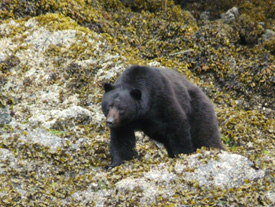
Camping and accommodation
Gwaii Haanas National Park Reserve, National Marine Conservation Area Reserve, and Haida Heritage Site
There is nothing like arriving at a place and feeling pure serenity. That’s what camping in Gwaii Haanas is like.
Pull up to a slice of beach and it becomes yours for the night. Gwaii Haanas has no formal campsites, but many small pebble beaches, sandy stretches, and headlands.
Please leave each place as you found it so that all visitors can share the wilderness experience. As well, try to stay out of sight and sound of other groups.
Closures
Some areas are permanently or temporarily closed to camping/access.
Follow these steps to minimize your "footprint"
Keep group size low
- Maximum group size is 12 people on shore at any one time and within sight and sound of other groups. This helps to reduce impact and maintain a wilderness feeling.
Location
- Whenever possible, camp on the sand or rock above the high tide line to minimize impact to local vegetation. Choose a spot for gathering and cooking that is least likely to damage shoreline vegetation.
- Camp away from the mouths of streams, especially during salmon spawning season (mid-August on).
Campfires/cooking/dishes

A beach kitchen © Parks Canada / Barb Johnston
- Use a portable stove to cook your food.
- Keep any campfires below the high tide line and away from drift logs. Use driftwood for your firewood not understory branches. Keep the fire small so it burns to ash and the next incoming tide will wash it away.
- Remove charcoal and scatter any rocks used for a hearth. Do not stir the ashes into the sand and gravel, as they will then take longer to wash away.
- Wash your dishes in the ocean with biodegradable soap and sand as a natural scrubber.
- After eating, immediately burn food scraps or bag them securely for packing out. Return fish entrails to the sea. Bears and other animals are quickly attracted to kitchen waste, even if it has been buried. Improperly handled food waste can create a dangerous situation for the next camper.
Hang Food
- Bring ropes and a food storage system to hang food out of reach of animals.
Reduce garbage
- Reduce the amount of garbage you create. Plan meals so that you don’t have a lot of uneaten food.
- Choose packaging that is lightweight, compact, and reusable.
- Pack out all garbage. Burn toilet paper and paper in your campfire, but do not burn cans, foil, or plastics, or throw these and other garbage into the ocean.
Toilet
- Use the intertidal flush. Make your deposit as close as possible to the water line, and cover with a rock afterwards so others do not step on it. Micro-organisms in the marine soil effectively decompose faeces.
- If you have no alternative, you can use the bush. Dig a small 20-centimetre (8-inch) deep hole away from animal trails and at least 100 metres/yards from water sources. Bury waste completely with soil. Never bury toilet paper or feminine hygiene products. Treat feminine hygiene products as garbage and pack out.
- Use small amounts of biodegradable soap when bathing. Select a location near the mouth of the stream and downstream from any place where people gather water for drinking.
 A bear in the intertidal zone
A bear in the intertidal zone © Parks Canada / C. Bergman
Respect
- Most areas that visitors find suitable for camping have historically been used by the Haida. These locations have important ecological, spiritual, and archaeological values.
- Treat each campsite as an archaeological site. Do not dig through middens or otherwise disturb any historical features.
- Be Bear Aware
Before you leave your campsite:
- Dismantle beach furniture. Put logs and rocks back in random positions.
- Pick up all garbage including the tiny pieces like twist ties, paper fragments, and tent pegs.
Warning
If Gwaii Haanas staff finds an unattended campsite where food, toiletries, garbage, or other wildlife attractants are left out, they will secure the attractants in a tree near the camp. They will leave a note and will follow up with a visit later in the day to ensure that the visitors understand the importance of keeping these materials out of reach of wildlife.
Related links
- DIY activities
- Explore ancient Haida village sites
- K’angGuu Gwaay.yaay, Plant Enclosures
- Cruise through an ocean teeming with wildlife
- Kayak up-close to nature and Haida culture
- Powerboating and Sailing
- Bird Watching
- Kayaking
- Marine mammal watching
- Fishing
- Hiking
- 'Laana DaaG̲ang.nga, Swan Bay Rediscovery program
- Volunteer
- Speakers series
- Artists in Gwaii Haanas
- Tours and programs
- Calendar of events
- Date modified :